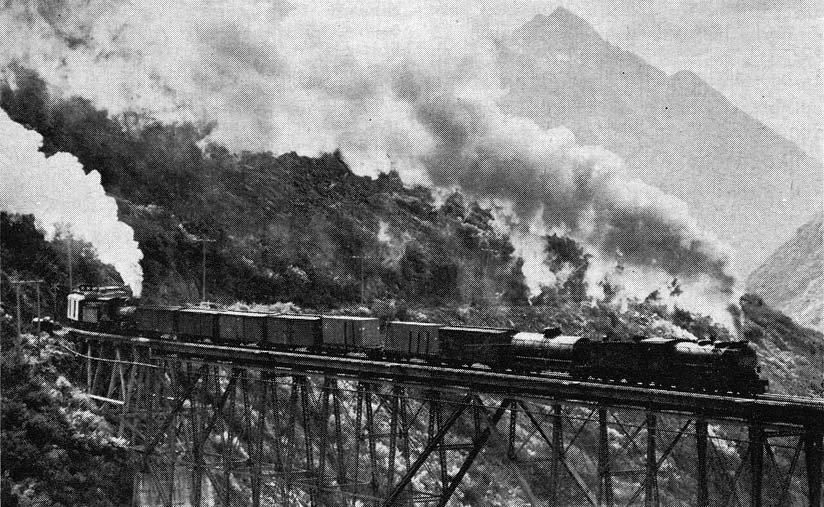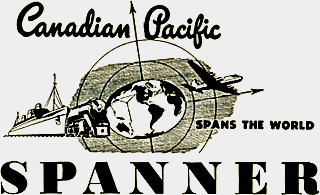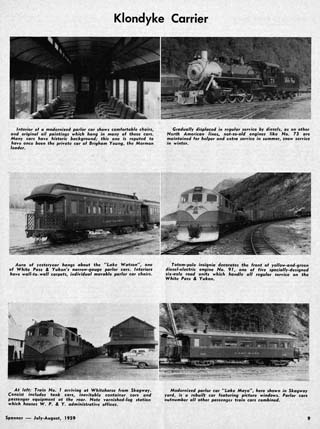
Sixty years after the Yukon gold rush, romance still rides
the narrow gauge rails of the White Pass & Yukon
Route.


Much has been made of the misery and suffering of both gold seekers and their pack animals, in effecting the perilous and forbidding passage from Skagway over Chilkoot and White Passes, to the Yukon interior, but today the tourist, in search of the places where fortunes were lost as quickly as they were made, finds comfort in the trip over White Pass by the famed White Pass & Yukon Route, the 110 mile railway line which connects Skagway, Alaska at the head of the Lynn Canal, with Whitehorse, in Yukon Territory.
The WP&YR is itself the gold rushes most hardy product. Conceived in the same spirit of adventure which caused so many people to go north at any cost, it has remained to play a more useful part in the development of the northern lands. Until the Second World War, the WP&YR was the only direct surface route into the Yukon. Today, the railway is the middle link in a freight transportation chain which carries container-laden goods from the Canadian and United States west coasts to Skagway by steamer, over the White Pass to Whitehorse by rail, thence by truck to Alaska Highway points beyond Whitehorse, all without intermediate reloading. This adaptation has been made without losing, for the railway's tourist-passengers, much of the flavour which characterized travel on the frontier of sixty years ago.
For one thing, the WP&YR is a narrow-gauge railway and it has managed to exist as such to a time when the narrow-gauge is all but a memory in continental North America. The retention of the narrow track width of three feet has been decided by two principal factors, the first being the WP&YR's complete physical isolation from other railways, the other the rather formidable plan and profile which the small track pursues, particularly its climb from Skagway to the summit of White Pass, where a difference in elevation of 2,900 feet is conquered in only twenty miles.
The WP&YR is a unit name used to designate the three corporately-separate railway companies of which it is comprised. They are, the Pacific & Arctic Railway & Navigation Company in the State of Alaska, the British Columbia Yukon Railway Company in British Columbia, and the British Yukon Railway Company in Yukon Territory. These three companies operate 20.4, 32.2 and 58.1 miles of railway respectively, giving a total route mileage of 110.7. The boundary between the State of Alaska and the Province of British Columbia is in White Pass, while that between British Columbia and Yukon Territory is at mileage 52.6 from Skagway, on the shores of Lake Bennett.
Trains leaving Skagway face an average 2.6 percent upgrade which extends to White Pass, and reaches an extreme of 3.9 percent. Even to keep to this figure, the direct-line distance of 14 miles from Skagway to the Pass had to be lengthened to 20.4 miles by taking the railway out of the main valley of the Skagway River in two diversions, one into the valley of the East Fork, the other into that of the North Fork at Glacier station. As the northbound train enters each of these side valleys, the continuing line can be discerned far up on the opposite slope. There are many curves, trestles, and concrete retaining walls, and even one tunnel, the only one on the line, before reaching Inspiration Point, Alaska, where southbound trains usually stop for a magnificent distant view of the Lynn Canal at Skagway, twelve miles away and half-a-mile lower in altitude. As the train clings to the sheer walls, the passenger is reminded of the harrowing tales of derailments in the first days of the railway, which old timers are fond of telling. North of Inspiration Point, the railway crosses another intersecting valley, that of Dead Horse Gulch, on a magnificent steel viaduct whose deck is 215 feet above the valley floor. This carries the line into White Pass proper where, low down on the left, an insignificant rock-strewn trail, now wiped out by slides in many places, marks the famed "Trail of '98". White Pass itself is the site of three snow sheds, which testify to an average annual snowfall here in excess of five hundred inches. The 2,885 foot elevation at this latitude enables one to be within throwing distance of snow practically all year round.
White Pass is not the actual summit of the White Pass railway, this occurs four miles further on, in British Columbia, at an elevation of 2,940 feet. After passing Log Cabin, B.C., the railway descends through a rock-strewn landscape to the shores of Lake Bennett, at Bennett, B.C. Bennett, whose principal landmark is an abandoned church up on a bluff overlooking the lake, and surrounded by snow-covered peaks, is the lunch stop for passengers travelling the WP&YR. Long tables loaded with excellent food in gonerous quantities feed the passengers boarding house style. Appetites are ravenous and in short order, the passengers of the northbound train, along with their counterparts southbound to Skagway (the two trains meet at Bennett), reduce the food to fragmentary proportions.
Continuing northward, the line lies along the eastern shore of Lake Bennett, whose waters reflect the mountain peaks on the opposite shore. Many opportunities for photographs of mountain scenery exist along this section, which continues for twenty-seven miles to Carcross, a shortened version of the settlement's original name "Caribou Crossing". At Carcross, the disused WP&YR steamer (paddle-wheeler) "Tutshi" can be seen, hauled up on ways out of the water, another relic to be seen here is the venerable locomotive "Duchess", which formerly worked a portage railway near Atlin, B.C., but whose service on the Canadian west coast goes back to 1876.
The remainder of the route to storied Whitehorse lies through the valleys of the Watson River and Cowley Creek. At one point, a dried-up lake bed testifies to an early attempt to lower a lake level by a few feet to make way for the railway. The discharge force of the water released through an artificial channel was misjudged, however, and the lake level descended eighty feet, until today it is but a succession of ponds. The course of the line along here lies beside Gray Ridge, a succession of snow-topped mountains. At MacRae, seven miles before Whitehorse, the Alaska Highway is crossed. Soon the train is skirting the foot of the plateau on which Whitehorse airport is situated, and then into the town itself where the railway headquarters are housed in an attractive varnished-log station. This is the end of the line for passenger trains, but the freight cars are handled a mile further through the town to a highway terminal where road-rail transshipment is carried out. As at Carcross, more disused steamers are to be seen here, all of which once played important parts in interior communications until the advent of the Alaska Highway and ancillary roads made them obsolete.
The antique appearance of the WP&YR train belies its modern interior appointments, there is only one class of travel for the tourist, first class, and the tiny, picturesque, open-vestibule parlour cars are fitted with attractive upholstered parlour car chairs every bit as comfortable as those in the "Canadian" or the "Dominion". The rolling stock is not without its history as well. One of the parlour cars, the "Lake Bennett", is reputed to have once been the private car of Brigham Young, the American Mormon leader, in Utah, and belonged to several Canadian and United States narrow-gauge railways before coming to the Yukon at the turn of the century.
The regular trains on the White Pass are mixed trains, in addition to the passenger cars, freight cars including flat cars carrying containers of merchandise and supplies are handled in the train. These containers are unloaded from ships at Skagway, and are destined for points farther up the Alaska Highway from Whitehorse. The containers are painted in various distinctive colours, depending upon the type of lading. Within the past few years, economics have dictated dieselization of motive power on the White Pass railway, and five specially-designed diesel-electric engines haul the greater part of the traffic, supplemented by six efficient steam locomotives, several of which are not much older than the diesels. The WP&YR is thus a railway of contrasts, but the land that it serves is no less so.
When the news of George Carmack's gold strike on Bonanza Creek, in Yukon territory, on 17 Aug 1896 reached the west coast of Canada and the United States, the Klondyke rush began. So vividly did the strike spark the imagination of the adventurous that forty thousand individuals made the trip by water to Skagway, thence by foot over Chilkoot Pass and White Pass into Yukon Territory in the years 1897 and 1898. Dawson City, the site of a trapper's hut in the autumn of 1896, had become a city of nearly 10,000 people by the summer of 1901. In the eight years following Carmack's discovery, nearly $100,000,000 in gold was taken from the Bonanza Creek area alone!
On the heels of the gold seekers came the railway builders. As soon as the snow had disappeared in the winter of 1897-1898, surveyors arrived at Skagway and in April, 1898, surveys for the railway which was to overcome the most difficult part of the Klondyke trek began. The principal figures in the construction of the railway were Michael J. Heney, an engineer, who joined with two other men of his own profession, Sir Thomas Tancrede, of London, and Samuel H. Graves, an American, in the undertaking of the railway which was to tap the rich traffic then struggling on foot over the passes. Five different surveys were traced for the route to White Pass, but the final line adopted was a compromise route, which had the effect of lengthening the fourteen miles to the Pass, to twenty miles. Even so, grades reached a maximum of 3.9 percent and curves of 16 and 20 degrees were not uncommon. It was on this section that the road's only tunnel, 250 feet long, and its highest bridge, Dead Horse Gulch Viaduct, were located.
On 21 Jul 1898, less than four months after surveys commenced, the first passenger train ever to operate in the former Territory of Alaska, hauled passengers on flat cars for four miles out of Skagway. Nine days after the first run, the Company was given official consolidated status organized in London, England under the name of the White Pass & Yukon Railway Company Limited. This Company was registered to carry out the charter rights and concessions of the three constituent companies which still exist today. Samuel Graves became the first President, while the Chairman of the Board was Charles Colin Macrae, of London. Eight-and-a-half months only were required to finish the railway to White Pass, and by mid-February 1899, the slim gauge rails had entered British Columbia. This point would have been attained by Christmas of 1898, had it not been for the Atlin gold rush in August, 1898. When the news of the strike reached the railway construction camp, the men deserted en masse, taking their tools with them. Samuel Graves remarked later in his memoirs that no railway ever constructed had ever hired labourers of such education and intelligence. The men were recruited from among the gold-seekers, and included, according to Graves, "lawyers, doctors, artists, college graduates, French chefs, and schoolmasters". On 6 Jul 1899 the first train ran from Skagway to Bennett. Due to heavy work on the precipitous eastern shore of the lake, it was decided to use steamers on Lake Bennett, and work on construction from Carcross to Whitehorse, while rock gangs blasted out the right-of-way in the middle section. This took another year, and with the completion of the line between Carcross and Whitehorse on 8 Jun 1900 the railway was able to offer a through connected rail and steamship service throughout its 110 mile route. By this time, the grade along the shore of Lake Bennett had been cleared and made, and the laying of the rails took but a month-and-a-half. On 29 Jul 1900, the last spike was driven at Carcross at the north end of the bridge across the lake narrows by a number of dignitaries. President Graves drove the last spike home.
Although the WP&YR was projected to run as far as Fort Selkirk, Yukon, about 325 miles, it has never been extended past Whitehorse. For a brief period around the first World War, the route mileage of the railway exceeded the present 104.7 while an 11 mile mining branch was operated to Pueblo, near Whitehorse.
For many years, too, the White Pass operated its own steamer service on the Yukon River as far as Dawson City, 450 miles away. This service was organized by the Company in 1901 in order to protect its own interests. Previous to that time, competing steamers carried traffic onward from Whitehorse down the Yukon River, but after a number of incidents involving loss or damage to goods turned over by the railway, the subsidiary British Yukon Navigation Company was formed to carry on this service. Its function ceased a number of years ago, and the half-dozen remaining sternwheel steamers are tied up at Whitehorse and Carcross. In addition to the Yukon River service, another service was operated until recent years from Carcross to Atlin, B.C. and West Taku Arm.
Many visitors travel to Skagway and the Yukon by the Canadian Pacific's "Inside Passage" steamship route from the west coast. For those, like the author, to whom time is an important factor, Canadian Pacific Air Lines provides daily flights to Whitehorse from Vancouver and Edmonton. It is but a step from the cosmopolitan atmosphere of a CPA "Empress" DC-6 airliner to the other-worldliness of the WP&YR, but it encompasses all of the charm of the Yukon and of the Klondyke gold-rush which brought riches to some, ruin to many, adventure and hardship to all. Today, all that remains of gold rush times are a few ghost towns, historical relics and souvenirs of pioneer days, and the celebrated literature of Robert W. Service and others.
History, however, has dealt mercifully with the most enduring product of the "days of '98", the
railway. Modernized today to play
a part in the opening-up of the Canadian and American North, the little railway nonetheless retains its atmosphere of the times when fortunes were to be
had for the taking, and the notorious outlaw "Soapy" Smith terrorized Skagway until put down by the railwaymen acting on behalf of law and
order. It retains, above all, its incomparable scenery. When the North finally comes into its own, it will be due in large measure to the transportation
link provided by what may well become North America's last three-foot-gauge common carrier, the White Pass & Yukon Route, a contribution as
important in its own way as that of our own Canadian Pacific in making the confederation of Canada an accomplished fact only a dozen years before the
Klondyke Rush.
 and is reprinted here with their permission.
All photographs, logos, and trademarks are the property of the Canadian Pacific Railway Company.
and is reprinted here with their permission.
All photographs, logos, and trademarks are the property of the Canadian Pacific Railway Company.See more of the WP&YR in this article.
in this article.

